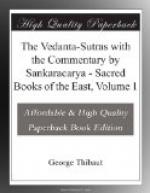* * * * *
The present translation of the Vedanta-sutras does not aim at rendering that sense which their author may have aimed at conveying, but strictly follows Sa@nkara’s interpretation. The question as to how far the latter agrees with the views held by Badaraya/n/a has been discussed above, with the result that for the present it must, on the whole, be left an open one. In any case it would not be feasible to combine a translation of Sa@nkara’s commentary with an independent version of the Sutras which it explains. Similar considerations have determined the method followed in rendering the passages of the Upanishads referred to in the Sutras and discussed at length by Sa@nkara. There also the views of the commentator have to be followed closely; otherwise much of the comment would appear devoid of meaning. Hence, while of course following on the whole the critical translation published by Professor Max Mueller in the earlier volumes of this Series, I had, in a not inconsiderable number of cases, to modify it so as to render intelligible Sa@nkara’s explanations and reasonings. I hope to find space in the introduction to the second volume of this translation for making some general remarks on the method to be followed in translating the Upanishads.
I regret that want of space has prevented me from extracting fuller notes from later scholiasts. The notes given are based, most of them, on the tikas composed by Anandagiri and Govindananda (the former of which is unpublished as yet, so far as I know), and on the Bhamati.




